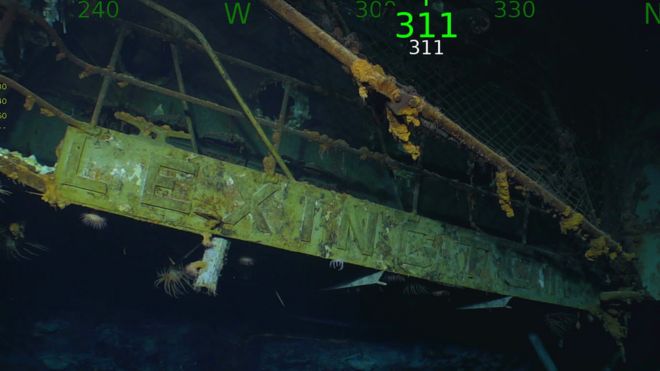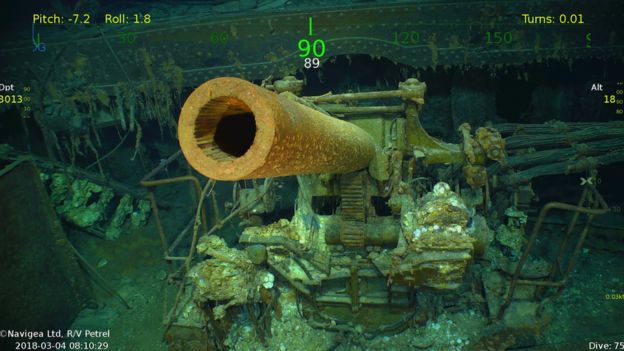USS Lexington (CV2) i 1943 - Wikipedia
05:30 inn i denne videoen ser du fartøyets endeligt:
https://tinyurl.com/ydfpy7ag
Utdrag fra historien:
May 8th saw each carrier group only 200 miles apart and both spotted the other in turn, launching their warplanes. Shokaku was hit twice by USS Yorktown dive-bombers, one bomb disabling the launch deck and essentially taking her out of the fight. USS Lexington's aircraft arrived late but an aviator managed a hit to Shokaku to worsen the damage. While she survived the battle, she lost most of her air group at Coral Sea.
On the other side of the battlefield, a 69-strong Japanese aircraft group appeared and laid a direct hit on Yorktown but the resulting destruction was not overly critical to operations. At the same time, Japanese aircraft engaged Lexington and hit her squarely with two torpedoes along her forward portside bow. Simultaneously, Japanese dive-bombers swooped in and managed two direct hits on her from above - one on the funnel structure and one on the forward portside flight deck. The attack jammed the Lexington's elevator in the raised position but her flightdeck was left intact.
The direct blasts and near misses of the Japanese bombs and torpedoes did more internal damage than initially noted. The ripple effect of the explosions had jarred aviation fuel tanks under her flightdeck that, though the internal fires had been put out by crews, the explosive gasses still permeated about the confines of the ship. Approximately an hour after the initial explosions were felt, a seemingly random spark occurred somewhere in the ship, in turn igniting the potent gasses, causing a series of explosions to ripple about the vessel and fires broke out. The ship listed to port and billowed smoke.
Realizing the Lexington was most likely a loss, the remaining aircraft were ordered to fly to their new home aboard the USS Yorktown. Lexington herself was subsequently abandoned per captain's order at 17:00 hours and ultimately done in by two torpedoes from the destroyer USS Phelps to prevent her capture by the enemy. In true honorable fashion, the last persons to leave the ship were Captain Frederick Carl Sherman and his Executive Officer, Commander Morton T. Seligman. The USS Lexington was officially given to the sea at 19:56 and her part in the war was over. She was struck from the US Naval Register on June 24th, 1942. During her World War 2 tenure, the ship earned herself and her crews the American Defense Service Medal, the Asiatic-Pacific Campaign Medal (with 2 Stars) and the World War 2 Victory Medal. Of the 2,951 crew aboard Lexington at the time of the Battle of Coral Sea, 216 were killed in action.
On the other side of the battlefield, a 69-strong Japanese aircraft group appeared and laid a direct hit on Yorktown but the resulting destruction was not overly critical to operations. At the same time, Japanese aircraft engaged Lexington and hit her squarely with two torpedoes along her forward portside bow. Simultaneously, Japanese dive-bombers swooped in and managed two direct hits on her from above - one on the funnel structure and one on the forward portside flight deck. The attack jammed the Lexington's elevator in the raised position but her flightdeck was left intact.
The direct blasts and near misses of the Japanese bombs and torpedoes did more internal damage than initially noted. The ripple effect of the explosions had jarred aviation fuel tanks under her flightdeck that, though the internal fires had been put out by crews, the explosive gasses still permeated about the confines of the ship. Approximately an hour after the initial explosions were felt, a seemingly random spark occurred somewhere in the ship, in turn igniting the potent gasses, causing a series of explosions to ripple about the vessel and fires broke out. The ship listed to port and billowed smoke.
Realizing the Lexington was most likely a loss, the remaining aircraft were ordered to fly to their new home aboard the USS Yorktown. Lexington herself was subsequently abandoned per captain's order at 17:00 hours and ultimately done in by two torpedoes from the destroyer USS Phelps to prevent her capture by the enemy. In true honorable fashion, the last persons to leave the ship were Captain Frederick Carl Sherman and his Executive Officer, Commander Morton T. Seligman. The USS Lexington was officially given to the sea at 19:56 and her part in the war was over. She was struck from the US Naval Register on June 24th, 1942. During her World War 2 tenure, the ship earned herself and her crews the American Defense Service Medal, the Asiatic-Pacific Campaign Medal (with 2 Stars) and the World War 2 Victory Medal. Of the 2,951 crew aboard Lexington at the time of the Battle of Coral Sea, 216 were killed in action.
USS Lexington: Lost WW2 aircraft carrier found after 76 years
 PAUL G. ALLEN
PAUL G. ALLEN
The wreck of a US aircraft carrier that was sunk during World War Two has been found off the coast of Australia.
The USS Lexington was located at a depth of about 3km (2 miles) in the Coral Sea, about 800km off Australia's east coast.
The ship was lost in the Battle of the Coral Sea from 4-8 May 1942. More than 200 crew members died in the fighting.
The US Navy confirmed the ship had been discovered by a search team led by Microsoft co-founder Paul Allen.
Pictures showed the wreck to be well preserved.
The discovery of the Lexington, along with 11 of its 35 aircraft, was made by Mr Allen's company Vulcan on Sunday.
Adm Harry Harris, head of the US Pacific Command, praised the discovery.
"As the son of a survivor of the USS Lexington, I offer my congratulations to Paul Allen and the expedition crew of Research Vessel (R/V) Petrel for locating the 'Lady Lex'," he said on Tuesday.
 PAUL G. ALLEN
PAUL G. ALLEN
The Battle of the Coral Sea is considered a key moment in halting Japan's advance in the Pacific during the war.
The Lexington was scuttled by US forces after being struck by several Japanese torpedoes and bombs during the battle.
The US Navy said 216 crew members died after the ship was attacked. More than 2,000 others were rescued.
"Lexington was on our priority list because she was one of the capital ships that was lost during WWII," Vulcan spokesman Robert Kraft said.
Pictures from the seabed taken by the Petrel show the Lexington's nameplate and guns. Some of the ship's aircraft are also shown in remarkably good condition.
The ship will not be retrieved because the US Navy considers it to be a war grave.
Mr Kraft said it had taken about six months of planning to locate the ship.
 PAUL G. ALLEN
PAUL G. ALLEN
It has found other vessels including a Japanese warship, the Musashi, and an Italian naval vessel, Artigliere - both from the same era.




Ingen kommentarer:
Legg inn en kommentar
Merk: Bare medlemmer av denne bloggen kan legge inn en kommentar.